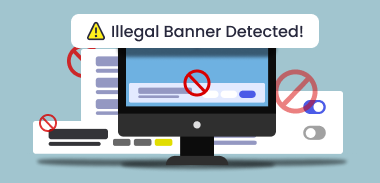Google Tag Manager and Cookie Consent: Stay Compliant Without Breaking Your Analytics
August 27, 2025
•
4 min read
Table of contents
back
to the top
Google Tag Manager and Cookie Consent: Stay Compliant Without Breaking Your Analytics
Google Tag Manager (GTM) is a favorite among marketers and developers for its ease of managing website tags without needing to edit code directly. But when it comes to GDPR compliance and cookie consent, the way GTM is used can have major legal implications.
If you're using GTM in the EU or targeting EU users, it's important to understand how GTM works, whether it uses cookies, and how it fits into your GDPR strategy especially with a Consent Management Platform (CMP) in place.

What is Google Tag Manager (GTM)?
Google Tag Manager is a free tag management system that allows you to install and update marketing, analytics, and tracking scripts also known as “tags” on your website without editing source code.
Instead of placing each tag manually, you insert the GTM container on your site once. After that, you can:
- Add or remove tracking codes (e.g., Google Analytics, Facebook Pixel)
- Set triggers and rules (e.g., fire this tag only on product pages)
- Manage everything from the GTM interface without needing a developer
Does Google Tag Manager Use Cookies?
By itself, GTM does not store or read cookies, nor does it collect personal data directly.
However, the tags it loads (such as Google Analytics, Facebook Pixel, Hotjar, etc.) can and often do set cookies, track users, or collect personal data.
So while GTM itself is cookie-neutral, it can enable non-compliant behavior if it loads tracking scripts before user consent is obtained.
GTM and the GDPR: What’s the Risk?
Under the General Data Protection Regulation (GDPR), you must:
- Obtain freely given, informed, and explicit consent before storing or accessing non-essential cookies (e.g., analytics, marketing)
- Provide transparency on what each tag does
- Allow users to opt out of categories like marketing or analytics
If GTM is configured to fire tags before consent, you may be:
- Violating GDPR and ePrivacy rules
- Risking enforcement actions or fines
- Undermining user trust
That’s why businesses using GTM must integrate it properly with a CMP.
How to Make Google Tag Manager GDPR-Compliant
1. Use a Consent Management Platform (CMP)
A GDPR-compliant CMP lets you:
- Display a consent banner to EU users
- Categorize cookies and tags (e.g., strictly necessary, analytics, marketing)
- Store and log user consent preferences
- Integrate with GTM to control when tags fire based on consent
Most CMPs provide a Consent Mode or Tag Manager Template to make this seamless.
2. Block Tags Until Consent is Given
Using GTM’s built-in features, you can:
- Set triggers to only fire tags if the user has consented to specific categories
- Use dataLayer events (e.g.,
consent.given) to manage tag firing logic - Prevent analytics and advertising tags from loading before consent
3. Use Google Consent Mode (Optional)
Google Consent Mode works with GTM and Google tags to:
- Delay or adjust tag behavior based on user consent
- Collect limited, anonymous signals until consent is given
It’s not a full CMP — it’s meant to supplement one. Consent Mode still requires a front-end CMP to collect valid GDPR consent.
CMPs and GTM: A Privacy-First Partnership
Integrating a CMP with Google Tag Manager gives you full control over which tags load and when.
Here’s what the integration typically looks like:
- The CMP collects consent on page load.
- Consent preferences are pushed to the
dataLayer. - GTM reads consent categories from the
dataLayer. - Only tags that match the approved categories are triggered.
This approach ensures:
- Full compliance with GDPR and ePrivacy
- Minimal disruption to marketing and analytics
- Audit-ready consent records for regulators
Final Takeaway
Google Tag Manager is not inherently non-compliant, but how you use it can make or break your GDPR strategy.
To stay compliant:
- Use a CMP that integrates smoothly with GTM
- Block non-essential tags until valid consent is obtained
- Consider Google Consent Mode as a supporting layer
When implemented correctly, GTM can remain a powerful tool without sacrificing user trust or violating data protection laws.
Sources
Explore further

Geo-Targeted Consent Banners: How Smart CMPs Boost GDPR Compliance and UX
Geo-targeted consent banners adapt cookie prompts to user location, improving GDPR compliance for EU/UK visitors while reducing friction for others.
November 06, 2025
3 min

Why Your Cookie Banner Is Probably Illegal (And What to Do About It)
Your cookie banner might be illegal without you knowing. Many look fine but break GDPR rules, risking fines. Here's why—and how to fix it to stay compliant and build trust.
April 21, 2025
4 min

What to Look for in a CMP: A Buyer’s Checklist for 2025
Buyer’s checklist for CMPs in 2025: evaluate GDPR compliance, geo-targeting, consent logs, UX, accessibility, performance, pricing—and avoid dark patterns.
November 14, 2025
2 min



